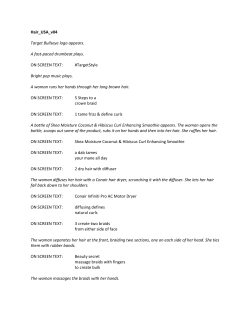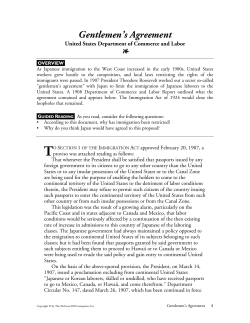
A STUDY OF KUMIHIMO PATTERNS By THL Siobhan nic Dhuinnshleibhe
A STUDY OF KUMIHIMO PATTERNS AND TRIBUTE TO AN OLD FRIEND OF HAWKWOOD By THL Siobhan nic Dhuinnshleibhe Minister of Arts and Sciences, Barony of Hawkwood For over 20 years, the residents of Hawkwood have been meeting in Weaver Park here in Asheville most Sundays for fighter practice. We’re fairly easy to spot – just look for the folks in armor or on-lookers with their arts and crafts all gathered under the big oak tree next to the parking lot. That tree has always been there, sheltering us from the sun and rain as we watch our fighters - and occasionally thumping us with an acorn or dead limb when it thinks we need it! On this special day, I wanted to have some representation of Hawkwood’s old friend here to celebrate with us, but wasn’t quite sure how to go about doing it. A few sleepless nights sitting in front of the television gave me the idea to use kumihimo, a form of braiding used by the Japanese for centuries, in order to give tribute to this unofficial member of our group and allow it to be present with us today at our Investiture. As I had been experimenting with more complex braid structures, I was also inspired to make some of these braids in our baronial colors and hang from the tree branches in order to introduce observers to the wide variety of patterns that kumihimo can offer. HISTORY OF KUMIHIMO Kumihimo comes from the words “kumi” meaning to plait or braid, and “himo”, meaning string, cord or braid. The distinctive feature of braiding is the movement of three or more strands that obliquely intersect with each other to create an intertwined surface pattern that can provide increased strength and flexibility in either a flat or a round form. The techniques used in kumihimo can be used to create both forms of these braids. Kumihimo as I have created it here are made on a wooden stand called a maru-dai, which is Japanese for “round stand.” Four wooden legs are attached to a base and support a circular wooden top with a sloping hole in the center, called a kagami or “mirror”. Bundles of threads wound around equally weighted bobbins called tama are distributed around the surface of the kagami, and run through the hole in the center where they are tied together and held in place by a counterbalance bag of weights, called omori. Varying the weight of the tama and the ratio of weight in the omori can affect the tightness and smoothness of kumihimo. Varying the colors on the tama and where you place those tama when starting to braid can affect the style of the kumihimo you create, as can be seen by the braid next to the maru-dai. Four different patterns emerge following the same braiding movements, depending on the starting positions of colors on the tama as you braid. Kumihimo has been used in many forms, from Buddhist events and accoutrements to clothing embellishment to practical lacing for armor and weaponry. Although kumihimo were originally made of plant fibers, silks were also used. The first kumihimo made of silk was found in 1988 from a stone coffin of Fujinoki Kofun (mid 6th century) that was 0.5 cm wide and 3 m long (Tada, 7). Although we have extant examples of kumihimo braids in museums and private collections across the world, little is known about the actual history of kumihimo itself. Not only are the fibers used to make the strings for kumihimo prone to decay, but no written information is found on instruction or patterning. The art of kumihimo was a closely guarded secret among its practitioners and passed down through oral tradition. Braiding dates back to at least the Jomon (which takes it’s name from the cord-marking found on a pottery fragment) and Yayoi periods of Japanese history (8,000 BCE to 300 CE) where impressions of braided cords were found pressed into the sides of pottery fragments found in archaeological sites. In the Kofun era (300-500 CE) burial mounds for important leaders held pottery figures that were portrayed in ceremonial clothes adorned with belts, hair ties and garment ties all made from braided cords. When the traditions and belief of Buddhism and its sutras and scrolls that were often tied and decorated with braids worked their way into Japanese culture in the Nara period (645-784 CE), the need for making these braids grew from a functional use to a decorative use. Fragments of braids found from this period are probably the original structures from which kumihimo descends. Braids found in the Heian period (784-1184 CE) became increasingly complex, evolving into two forms: a flat wide supple braid called a Hirao that was worn by the Emperor and high-ranking officials as a belt, and core-carrying rope braids known as temple braids, since they were discovered hidden inside statues in temples. Many classes had specific kumihimo designs that could only be worn by people of certain rank or by members of the royal family (Tada, 9). The rise of the Samurai warriors in the Kamakura period (1185-133 CE) greatly increased the need for kumihimo, as the narrower bands in eight-foot lengths were used to lace together the many pieces of armor the warriors wore. Rodrick Owen in his book Braids: 250 patterns from Japan, Peru and Beyond, states that some 800-1000 feet of these kumihimo braids were needed to lace together one suit of armor. (15). Decorative braids were also used for sword hilts leggings and horse harnesses. As the times of war passed, the samurai were able to turn their attentions to matters of state and aesthetics, when the rise of the tea ceremony and artistic pursuits increased the use of decorative kumihimo braids in everyday life. In the late Edo period (1616-1867) the precursor of the maru-dai (the stand used to braid the kumihimo) was introduced, thus replacing the previously suspected technique of braiding involving loop manipulation techniques. The town of Edo (know known as Tokyo) became the center of kumihimo production during this time, and published works from this period include several sample books of kumihimo braids. During this time kumihimo came into fashion in costuming as an Obi-jime (sash-cord) to secure the tightening of the Obi (sash belt) and as an artistic accent to Kimonos as a whole. In the Meiji period (1867-1912 CE) brought great social changes in Japan. Machines were introduced that could make kumihimo bands, and an edict was passed in 1876 that prohibited people from carrying swords. Hand-made kumihimo declined in popularity until the mid 1970s, when schools of braid-making began appearing along with resurgence in publishing books on patterns of kumihimo that has continued to this day. CONSTRUCTION The tree is constructed of 4, 8 and 16-strand kumihimo done around a copper or nickel-wire core in handspun tan alpaca, dark brown Romney wool, and unbleached linen dyed with cutch (a period dyestuff from the heartwood of the Acacia tree (Acacia catechu) of South America). The wire was inserted into the beginning of the braid and held up by my shoulders or teeth as I braided around it on the maru-dai, similar to the picture below, left: Once I had a sufficient number of wired braids, I then braided those together in the 4-strand pattern “maru-yotsu” pattern by securing the ends to the top of my dining room light and braiding them over maru-dai, similar to the picture above, right. This resulted in 4 separate bundles of 4 braids each, which I then braided together to resemble the tree, allowing the bottom edges to spread like roots and twining some of the thinner braids together into stronger branches at the top of the tree. I made a short maru-dai out of clock-faces and dowel rods with a bigger hole than usual to use to support the tree, while demonstrating the type of device that was used to construct it. I then created an un-wired 8-strand braid in the “kawari-edo-yatsu” pattern with strands of all three handspun yarns, and placed the active braiding end in the center of the tree trunk to give the effect of the tree growing out of the maru-dai and developing braid. I wound the rest of the braid around the tree trunk to give it stability and allowed the edge to protrude beyond the base of the maru-dai to give the appearance of a tree root, leaving the counterweight bag with Hawkwood’s badge on the bottom of the braid. The braids hanging from the branches of the tree are a variety of Japanese braids from the books listed in the bibliography, done in Hawkwood’s colors of Azure, Argent and Or in a commercial 2-strand crochet cotton. (I could not afford enough silk to do all of these braids, and was too busy sewing regalia to spin and dye the silk myself!) They are 4, 8, 12, 15, 16 and 24-strand braids, and are identified by name with a label on the end of each braid. Eight of these braids I have been doing for years and have used to make cording, belts and trim) or the newcomer’s tokens you see today!), but the rest are ones that I had not yet tried and wanted to see how they turned out. Not only would this be a way to experiment on new braids, but it will also help me in introducing a wider variety of braid patterns in my classes to those who are interested in kumihimo, but aren’t quite ready to experiment with more than 4 strands! BIBLIOGRAPHY & REFERENCES Tada, Makiko. “ Maru-dai braids: 120 diagrams.” Comprehensive Treatise of Braids I. Tokyo. 1996. Owen, Rodrick. Braids: 250 Patterns from Japan, Peru and Beyond. Loveland: Interweave Press. 1995. Martin, Catherine. Kumihimo Japanese Silk Braiding Techniques. Asheville: Lark Books. 1991.
© Copyright 2025


















